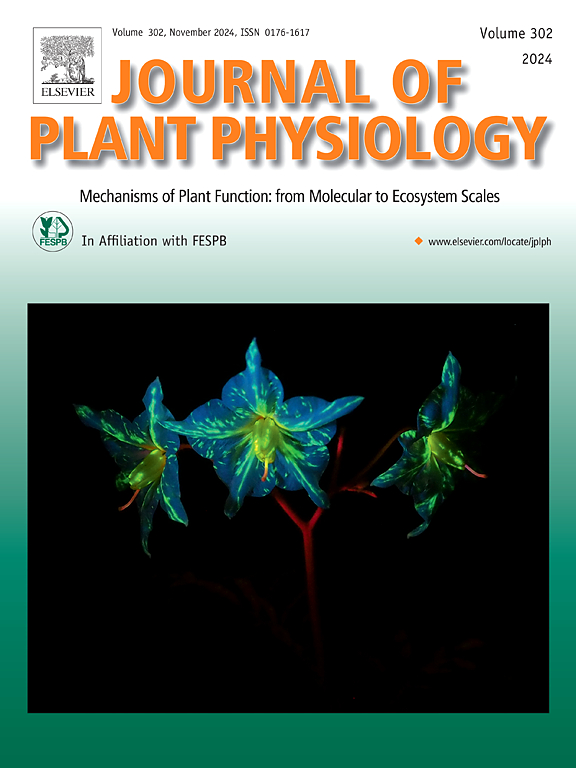茶树转录因子CsPAT1通过调节苯丙素的生物合成参与了茶树的抗旱性
IF 4.1
3区 生物学
Q1 PLANT SCIENCES
引用次数: 0
摘要
茶树,尤其是叶状经济作物,喜欢温暖潮湿的气候。我们之前的工作发现CsPAT1是茶树木质素生物合成的促进剂。CsPAT1在茶树非生物胁迫响应中的具体作用尚不清楚。在本研究中,我们发现CsPAT1在干旱、寒冷、高温和ABA处理下均有诱导表达。与野生型(WT)对照相比,CsPAT1转基因拟南芥品系表现出更强的耐旱性。干旱胁迫下转基因拟南芥的SOD和POD活性、脯氨酸含量及干旱响应基因表达量均显著升高。转录组分析显示,黄酮类生物合成途径中差异表达基因(DEGs)显著富集。相应的,CsPAT1转基因品系的总黄酮含量显著高于转基因品系。通过UPLC-MS /MS-based类黄酮代谢组分析,鉴定并定量了24种类黄酮代谢产物。值得注意的是,CsPAT1转基因品系的苯丙素和羟基肉桂酸水平显著降低,这两种物质是苯丙素生物合成的关键前体。相反,9种黄酮类化合物在转基因品系中显著升高,包括芹菜素、木犀草素7- o -葡萄糖苷、山奈素、柚皮素、丁素、儿茶素、生物茶素A、大豆苷和染料木素。这些发现提示CsPAT1可能通过调节苯丙素代谢途径增强抗旱性。研究结果为今后提高茶树耐旱性的育种策略提供了参考。本文章由计算机程序翻译,如有差异,请以英文原文为准。
The transcription factor CsPAT1 from tea plant (Camellia sinensis) is involved in drought tolerance by modulating phenylpropanoid biosynthesis
Tea plants, in particular, leafy cash crops, prefer warm and humid climates. Our previous work identified CsPAT1 as a facilitator of lignin biosynthesis in tea plants. The specific role of CsPAT1 in tea plants’ abiotic stress response remains unclear. In this study, we found that the expression of CsPAT1 in tea plants was induced under drought, cold, heat, and ABA treatments. CsPAT1 transgenic Arabidopsis lines displayed enhanced drought tolerance compared with wild-type (WT) controls. The SOD and POD activities, proline content, and expression levels of drought-responsive genes were significantly increased in transgenic Arabidopsis under drought stress treatment. Transcriptome analysis revealed a significant enrichment of differentially expressed genes (DEGs) in the flavonoid biosynthesis pathway. Correspondingly, total flavonoid contents were significantly higher in the CsPAT1 transgenic lines. Through UPLC–MS/MS-based flavonoid metabolome analysis, we identified and quantified 24 flavonoid metabolites. Notably, CsPAT1 transgenic lines exhibited significantly lower levels of phenylpropanoids and hydroxycinnamic acids, key precursors in phenylpropanoid biosynthesis. Conversely, nine flavonoid compounds were significantly elevated in the transgenic lines, including apigenin, luteolin 7-O-glucoside, kaempferide, naringenin, butin, catechin, biochanin A, daidzin, and genistein. These findings suggest that CsPAT1 may enhance drought resistance by regulating the phenylpropanoid metabolic pathway. Our results provide insights for future breeding strategies to enhance drought tolerance in tea plants.
求助全文
通过发布文献求助,成功后即可免费获取论文全文。
去求助
来源期刊

Journal of plant physiology
生物-植物科学
CiteScore
7.20
自引率
4.70%
发文量
196
审稿时长
32 days
期刊介绍:
The Journal of Plant Physiology is a broad-spectrum journal that welcomes high-quality submissions in all major areas of plant physiology, including plant biochemistry, functional biotechnology, computational and synthetic plant biology, growth and development, photosynthesis and respiration, transport and translocation, plant-microbe interactions, biotic and abiotic stress. Studies are welcome at all levels of integration ranging from molecules and cells to organisms and their environments and are expected to use state-of-the-art methodologies. Pure gene expression studies are not within the focus of our journal. To be considered for publication, papers must significantly contribute to the mechanistic understanding of physiological processes, and not be merely descriptive, or confirmatory of previous results. We encourage the submission of papers that explore the physiology of non-model as well as accepted model species and those that bridge basic and applied research. For instance, studies on agricultural plants that show new physiological mechanisms to improve agricultural efficiency are welcome. Studies performed under uncontrolled situations (e.g. field conditions) not providing mechanistic insight will not be considered for publication.
The Journal of Plant Physiology publishes several types of articles: Original Research Articles, Reviews, Perspectives Articles, and Short Communications. Reviews and Perspectives will be solicited by the Editors; unsolicited reviews are also welcome but only from authors with a strong track record in the field of the review. Original research papers comprise the majority of published contributions.
 求助内容:
求助内容: 应助结果提醒方式:
应助结果提醒方式:


